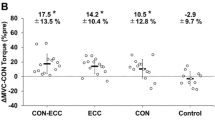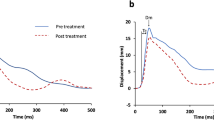Abstract
The purpose of this study was to examine the effect of isokinetic eccentric (ECC) and concentric (CON) training at two velocities [fast, 180° s−1 (3.14 rad s−1) and slow,30° s−1(0.52 rad s−1)] on muscle hypertrophy. Twenty-four untrained volunteers (age 18–36 years) participated in fast- (n=13) or slow- (n=11) velocity training, where they trained one arm eccentrically for 8 weeks followed by CON training of the opposite arm for 8 weeks. Ten subjects served as controls (CNT). Subjects were tested before and after training for elbow flexor muscle thickness by sonography and isokinetic strength (Biodex). Overall, ECC training resulted in greater hypertrophy than CON training (P<0.01). No significant strength or hypertrophy changes occurred in the CNT group. ECC (180° s−1) training resulted in greater hypertrophy than CON (180° s−1) training and CON (30° s−1) training (P<0.01). ECC (30° s−1) training resulted in greater hypertrophy than CON (180° s−1) training (P<0.05), but not CON (30° s−1) training. ECC (180° s−1) training resulted in the greatest increases in strength (P<0.01). We conclude that ECC fast training is the most effective for muscle hypertrophy and strength gain.





Similar content being viewed by others
References
Abe T, DeHoyos DV, Pollock ML, Garzarella L (2000) Time course for strength and muscle thickness changes following upper and lower body resistance training in men and women. Eur J Appl Physiol 81:174–180
Behm DG (1995) Neuromuscular implications and applications of resistance training. J Strength Cond Res 9:264–274
Bell GJ, Petersen SR, MacLean I, Reid DC, Quinney HA (1992) Effect of high velocity resistance training on peak torque, cross sectional area and myofibrillar ATPase activity. J Sports Med Phys Fitness 32:10–18
Bromstrand E, Ekblom B (1982) The needle biopsy technique for fibre type determination in human skeletal muscle- a methodological study. Acta Physiol Scand 116:437–442
Candow DG, Chilibeck PD, Burke DG, Davison KS, Smith-Palmer T (2001). Effect of glutamine supplementation combined with resistance training in young adults. Eur J Appl Physiol 86:142–149
Colliander EB, Tesch PA (1990) Effects of eccentric and concentric muscle actions in resistance training. Acta Physiol Scand 140:31–39
Coyle EF, Feiring DC, Rotkis C, Cote RW III, Roby FB, Lee W, Wilmore JH (1981) Specificity of power improvements through slow and fast isokinetic training. J Appl Physiol 51:1437–1442
Cureton KJ, Collins MA, Hill DW, McElhannon FM Jr (1988) Muscle hypertrophy in men and women. Med Sci Sports Exerc 20:338–344
Davies J, Parker DF, Rutherford OM, Jones DA (1988) Changes in strength and cross-sectional area of the elbow flexor as a result of isometric training. Eur J Appl Physiol 57:667–670
Duncan PW, Chandler JM, Cavanaugh DK, Johnson KR, Buehler AG (1989) Mode and speed specificity of eccentric and concentric exercise training. J Orthop Sports Phys Ther 11:70–75
Enoka RM (1996) Eccentric contractions require unique activation strategies by the nervous system. J Appl Physiol 81:2339–2346
Farthing JP, Chilibeck PD (2003) The effect of eccentric training at different velocities on cross-education. Eur J Appl Physiol (in press)
Fridén J, Sjöstrom M, Ekblom B (1983) Myofibrillar damage following intense eccentric exercise in man. Int J Sports Med 3:170–176
Gibala MJ, MacDougall JD, Sale DG (1994) The effects of tapering on strength performance in trained athletes. Int J Sports Med 15:492–497
Gibala MJ, MacDougall JD, Tarnopolsky MA, Stauber WT, Elorriaga A (1995) Changes in human skeletal muscle ultrastructure and force production after acute resistance exercise. J Appl Physiol 78:702–708
Goldberg AL, Etlinger JD, Goldspink DF, Jablecki C (1975) Mechanism of work-induced hypertrophy of skeletal muscle. Med Sci Sports Exerc 7:185–198
Higbie EJ, Cureton KJ, Warren GL III, Prior BM (1996) Effects of concentric and eccentric training on muscle strength, cross-sectional area, and neural activation. J Appl Physiol 81:2173–2181
Hortobágyi T, Katch FI (1990a) Eccentric and concentric torque–velocity relationships during arm flexion and extension. Eur J Appl Physiol 60:395–401
Hortobágyi T, Katch FI (1990b) Role of concentric force in limiting improvement in muscular strength. J Appl Physiol 68:650–658
Hortobágyi T, Barrier J, Beard D, Braspennincx J, Koens P, Devita P, Dempsey L, Lambert J (1996a) Greater initial adaptations to submaximal muscle lengthening than maximal shortening. J Appl Physiol 81:1677–1682
Hortobágyi T, Hill JP, Houmard JA, Fraser DD, Lambert NJ, Israel RG (1996b) Adaptive responses to muscle lengthening and shortening in humans. J Appl Physiol 80:765–772
Hortobágyi T, Lambert NJ, Hill JP (1997) Greater cross education following training with muscle lengthening than shortening. Med Sci Sports Exerc 29:107–112
Housh DJ, Housh TJ, Johnson GO, Chu W (1992) Hypertrophic response to unilateral concentric isokinetic resistance training. J Appl Physiol 73:65–70
Maughan RJ, Watson JS, Weir J (1983) Strength and cross-sectional area of human skeletal muscle. J Physiol (Lond) 338:37–49
O'Hagan FT, Sale DG, MacDougall JD, Garner SH (1995a) Comparative effectiveness of accommodating and weight resistance training modes. Med Sci Sports Exerc 27:1210–1219
O'Hagan FT, Sale DG, MacDougall JD, Garner SH (1995b) Response to resistance training in young women and men. Int J Sports Med 16:314–321
Paddon-Jones D, Leveritt M, Lonergan A, Abernethy P (2001) Adaptation to chronic eccentric exercise in humans: the influence of contraction velocity. Eur J Appl Physiol 85:466–471
Ryan LM, Magidow PS, Duncan PW (1991) Velocity-specific and mode-specific effects of eccentric isokinetic training of the hamstrings. J Orthop Sports Phys Ther 13:33–39
Sale DG, MacDougall JD, Always SE, Sutton JR (1987) Voluntary strength and muscle characteristics in untrained men and women and male bodybuilders. J Appl Physiol 62:1786–1793
Seger J, Arvidsson B, Thorstensson A (1998) Specific effects of eccentric and concentric training on muscle strength and morphology in humans. Eur J Appl Physiol 79:49–57
Staron RS, Karapondo DL, Kraener WJ, Fry AC, Gordon SE, Falkel JE, Hagerman FC, Hikida RS (1994) Skeletal muscle adaptation during early phase of heavy-resistance training in men and women. J Appl Physiol 76:1247–1255
Stauber WT (1989) Eccentric action of muscles: physiology, injury and adaptation. Exerc Sport Sci Rev 17:157–185
Stauber WT, Clarkson PM, Fritz V, Evans WJ (1990) Extracellular matrix disruption and pain after eccentric muscle action. J Appl Physiol 69:868–874
Stromberg BV (1986) Contralateral therapy in upper extremity rehabilitation. Am J Phys Med 65:135–143
Stupka N, Tarnopolsky MA, Yardley NJ, Philips SM (2001) Cellular adaptation to repeated eccentric exercise-induced muscle damage. J Appl Physiol 91:1669–1678
Tomberlin JP, Basford JR, Schwen EE, Orte PA, Scott SG, Laughman RK, Ilstrup DM. (1991) Comparative study of isokinetic eccentric and concentric quadriceps training. J Orthop Sports Phys Ther 14: 31–36
Westing HS, Seger JY, Thorstensson A (1990) Effects of electrical stimulation on eccentric and concentric torque-velocity relationships during knee extension in man. Acta Physiol Scand 140:17–22
Westing HS, Cresswell AG, Thorstensson A (1991) Muscle activation during maximal voluntary eccentric and concentric knee extension. Eur J Appl Physiol 62:104–108
Wickiewicz TL, Roy RR, Powell PL, Perrine JJ, Edgerton VR (1984) Muscle architecture and force–velocity relationships in humans. J Appl Physiol 57:435–443
Acknowledgements
We gratefully acknowledge the subjects who dedicated a great deal of time to participate in this study. We also acknowledge the technical assistance of Doug Jacobson. Jonathan Farthing is supported by a scholarship from The Natural Sciences and Engineering Research Council of Canada. The experiments described in this paper comply with the current laws of Canada.
Author information
Authors and Affiliations
Corresponding author
Rights and permissions
About this article
Cite this article
Farthing, J.P., Chilibeck, P.D. The effects of eccentric and concentric training at different velocities on muscle hypertrophy. Eur J Appl Physiol 89, 578–586 (2003). https://doi.org/10.1007/s00421-003-0842-2
Accepted:
Published:
Issue Date:
DOI: https://doi.org/10.1007/s00421-003-0842-2




